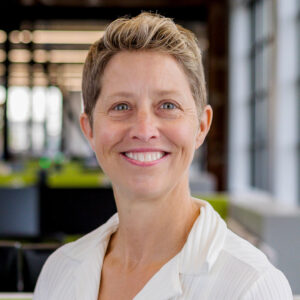The 2025 Environments for Aging Conference + Expo, held April 26-29 in Lexington, Ky., will feature a variety of keynote and educational sessions.
Environments for Aging is previewing some of the upcoming educational sessions in a series of Q+As with speakers, sharing what panelists plan to discuss and key takeaways they’ll offer attendees.
Monday. April 28, 3:45-4:45 p.m.
Speakers: Erin Anderson senior principal, director of interior design, SMRT Architects & Engineers; Mark Rogers, associate principal, SMRT Architects & Engineers
Project teams designing skilled nursing facilities in remote locations such as Northern Maine and Nantucket, Mass., face unique challenges related to resident, family, and staff needs. In this session, panelists will explore how design can improve staffing efficiency, enhance recruitment and retention, and create a supportive environment for both residents and staff.

Erin Anderson (Headshot credit: Courtesy of SMRT Architects & Engineers)
Environments for Aging: What are some of the biggest challenges project teams face on remote community projects?
Erin Anderson: One of the greatest challenges is balancing the need for advanced building systems and equipment with the realities of remote access. While we aim to specify the most efficient, sustainable, and future-ready systems, they often require specialized knowledge and parts that may not be readily available in remote areas.
In a skilled nursing environment—where downtime can directly impact resident safety and comfort—this becomes a critical consideration. Longevity and performance of equipment must be carefully weighed against maintainability and local service capacity.

Mark Rogers (Headshot credit: Courtesy of SMRT Architects & Engineers)
What design strategies are key to addressing these challenges?
Mark Rogers: Thoughtful design begins with a deep understanding of the facility’s operations and the capabilities of local tradespeople. We prioritize systems and materials, such as HVAC, plumbing fixtures, washer and dryer units, food service equipment, and flooring, all striking a balance between performance and practicality—durable, efficient, and also serviceable by local professionals.
Engaging early and often with facilities teams also helps ensure the design is aligned with on-the-ground realities.
Enhancing resident and staff well-being are also key project priorities. What strategies do you plan to share with attendees to address these goals?
Anderson: Two powerful drivers of well-being are connection and choice. For residents, creating environments that encourage social interaction and personal autonomy can significantly enhance quality of life.
For staff, a thoughtful layout, access to daylight, and spaces designed for comfort and restoration make a meaningful difference in their day-to-day experience.
What’s one takeaway from your session that you hope attendees walk away with?
Rogers: A renewed commitment to stakeholder engagement. The most rewarding projects are those that reflect the voices of everyone involved—from residents and families to staff and community members. Engaging these perspectives not only leads to better outcomes, but also to more meaningful, mission-driven design.
Find updates and additional information on the 2025 EFA Conference + Expo here.









